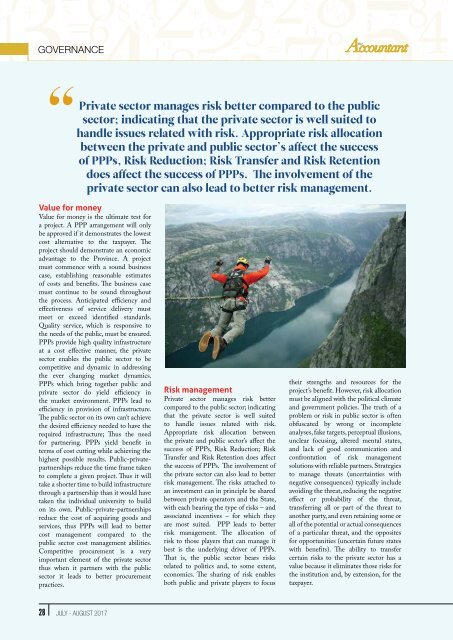The-Accountant-Jul-Aug-2017
Create successful ePaper yourself
Turn your PDF publications into a flip-book with our unique Google optimized e-Paper software.
Governance<br />
Private sector manages risk better compared to the public<br />
sector; indicating that the private sector is well suited to<br />
handle issues related with risk. Appropriate risk allocation<br />
between the private and public sector’s affect the success<br />
of PPPs, Risk Reduction; Risk Transfer and Risk Retention<br />
does affect the success of PPPs. <strong>The</strong> involvement of the<br />
private sector can also lead to better risk management.<br />
Value for money<br />
Value for money is the ultimate test for<br />
a project. A PPP arrangement will only<br />
be approved if it demonstrates the lowest<br />
cost alternative to the taxpayer. <strong>The</strong><br />
project should demonstrate an economic<br />
advantage to the Province. A project<br />
must commence with a sound business<br />
case, establishing reasonable estimates<br />
of costs and benefits. <strong>The</strong> business case<br />
must continue to be sound throughout<br />
the process. Anticipated efficiency and<br />
effectiveness of service delivery must<br />
meet or exceed identified standards.<br />
Quality service, which is responsive to<br />
the needs of the public, must be ensured.<br />
PPPs provide high quality infrastructure<br />
at a cost effective manner, the private<br />
sector enables the public sector to be<br />
competitive and dynamic in addressing<br />
the ever changing market dynamics.<br />
PPPs which bring together public and<br />
private sector do yield efficiency in<br />
the market environment. PPPs lead to<br />
efficiency in provision of infrastructure.<br />
<strong>The</strong> public sector on its own can’t achieve<br />
the desired efficiency needed to have the<br />
required infrastructure; Thus the need<br />
for partnering. PPPs yield benefit in<br />
terms of cost cutting while achieving the<br />
highest possible results. Public-privatepartnerships<br />
reduce the time frame taken<br />
to complete a given project. Thus it will<br />
take a shorter time to build infrastructure<br />
through a partnership than it would have<br />
taken the individual university to build<br />
on its own. Public-private-partnerships<br />
reduce the cost of acquiring goods and<br />
services, thus PPPs will lead to better<br />
cost management compared to the<br />
public sector cost management abilities.<br />
Competitive procurement is a very<br />
important element of the private sector<br />
thus when it partners with the public<br />
sector it leads to better procurement<br />
practices.<br />
Risk management<br />
Private sector manages risk better<br />
compared to the public sector; indicating<br />
that the private sector is well suited<br />
to handle issues related with risk.<br />
Appropriate risk allocation between<br />
the private and public sector’s affect the<br />
success of PPPs, Risk Reduction; Risk<br />
Transfer and Risk Retention does affect<br />
the success of PPPs. <strong>The</strong> involvement of<br />
the private sector can also lead to better<br />
risk management. <strong>The</strong> risks attached to<br />
an investment can in principle be shared<br />
between private operators and the State,<br />
with each bearing the type of risks – and<br />
associated incentives – for which they<br />
are most suited. PPP leads to better<br />
risk management. <strong>The</strong> allocation of<br />
risk to those players that can manage it<br />
best is the underlying driver of PPPs.<br />
That is, the public sector bears risks<br />
related to politics and, to some extent,<br />
economics. <strong>The</strong> sharing of risk enables<br />
both public and private players to focus<br />
their strengths and resources for the<br />
project’s benefit. However, risk allocation<br />
must be aligned with the political climate<br />
and government policies. <strong>The</strong> truth of a<br />
problem or risk in public sector is often<br />
obfuscated by wrong or incomplete<br />
analyses, fake targets, perceptual illusions,<br />
unclear focusing, altered mental states,<br />
and lack of good communication and<br />
confrontation of risk management<br />
solutions with reliable partners. Strategies<br />
to manage threats (uncertainties with<br />
negative consequences) typically include<br />
avoiding the threat, reducing the negative<br />
effect or probability of the threat,<br />
transferring all or part of the threat to<br />
another party, and even retaining some or<br />
all of the potential or actual consequences<br />
of a particular threat, and the opposites<br />
for opportunities (uncertain future states<br />
with benefits). <strong>The</strong> ability to transfer<br />
certain risks to the private sector has a<br />
value because it eliminates those risks for<br />
the institution and, by extension, for the<br />
taxpayer.<br />
28 JULY - AUGUST <strong>2017</strong>

















